Bradshaw:Glossary: Difference between revisions
(→A: AB) |
(→T: TCB) |
||
| Line 335: | Line 335: | ||
*'''TC''': Track Circuit | *'''TC''': Track Circuit | ||
*:Part of the signalling system, where a simple electronic device is used to help detect the presence of a train. See also [[#T|TCF]] and TSF. | *:Part of the signalling system, where a simple electronic device is used to help detect the presence of a train. See also [[#T|TCF]] and TSF. | ||
*'''TCB''': Track Circuit Block | |||
*'''TCD''': Traffic Controllers Diagrams | *'''TCD''': Traffic Controllers Diagrams | ||
*'''TCF''': Track Circuit Failure | *'''TCF''': Track Circuit Failure | ||
Revision as of 09:00, 27 April 2021
Not everyone knows all the hundreds of rail-specific acronyms and initialisms, so if any pop up in conversation on the Discord server, add them and their meaning below so others can look them up.
Please keep these in alphabetical order so it is easy to find a specific term.
0-9
- 4LM: Four Lines Modernisation programme
- 4 Foot The space between the two running rails on a section of track
- 6 Foot The area between a pair of running lines
- 10 Foot The area between two pairs of running lines
A
- AB: Absolute Block
- ABCL: Automatic Barrier Crossing, Locally Monitored
- ABDO: Automatic Braking and Door Opening
- ACOA: Adverse Change Of Aspect
- ACWN: Altered Carriage Working Notice
- AHB: Automatic Half-Barrier Crossing
- AHBC: Automatic Half-Barrier Crossing
- ANP: Auto Not Permitted
- An operating state on London Underground ATO lines where trains have been prevented from operating in ATO mode and must instead operate in CM or PM, normally initiated due to staff on our around the track area.
- AOCL: Automatic Open Crossing, Locally Monitored
- ARL: Arriva Rail London
- ARS: Automatic Route Setting
- ASC: Area Signalling Centre
- ASDO: Automatic Selective Door Opening. See also SDO and UDS
- ATC: Automatic Train Control
- ATO: Automatic Train Operation
- ATOC: Association of Train Operating Companies
- ATP: Automatic Train Protection
- ATS: Automatic Tram Stop
- ATW: Arriva Trains Wales
- AWC: Avanti West Coast
- AWS: Automatic Warning System
B

- BML: Brighton Main Line
- BR: British Rail
- BTC: British Transport Commission
- BTP: British Transport Police
C

- C+H: Circle and Hammersmith & City lines
- CAPE: Cancelled At Point of Entry
- CAWS: Continuous Automatic Warning System
- CBTC: Communications Based Train Control
- Name given to the SelTrac installation being installed on London Underground’s SSR as part of the 4LM project to enable ATO. See also TBTC and DTG-R
- CD: Close Doors (Indication)
- CDL: Central Door Locking
- CDP: Continuous Development Programme
- Cess: The area along either side of a railway line which is kept at a lower level than the sleeper bottom, in order to provide drainage.
- CIS: Customer Information System
- CLR: Central London Railway
- CM: Coded Manual
- A mode of operation used on London Underground’s Central and Victoria lines where the Train Operator drives the train manually at up to normal line speed using signalling information provided on an in-cab display. See also PM
- CMS: Competency Management System
- CoT: Close of Traffic
- CR: Chiltern Railways
- CRS: Computer Reservation System
- CS: Caledonian Sleeper
- CSA: Customer Service Assistant
- CSDE: Correct Side Door Enable
- CSL2: Customer Service Level 2
- CSLR: City & South London Railway
- CSR: Cab Secure Radio
- CTBC: Combined Traction Brake Controller, See also TBC
- CTRL: Channel Tunnel Rail Link
- CWN: Carriage Working Notice
D
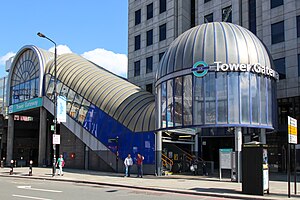
- DCO: Driver Controlled Operation
- A system of operation on the National Rail network where a train operates with both a driver and at least one other member of staff onboard, but where the driver is responsible for operation of the trains doors as well as driving the train.
- DCV: Door Closed Visual
- DDA: Disability Discrimination Act
- DISI: Defective in Service Instructions
- DLR: Docklands Light Railway
- DOO: Driver Only Operation
- A system of operation on the National Rail Network where the only member of operational staff onboard a train is the driver who is responsible for all aspects of the trains operation. Analagous to OPO on London Underground
- DRA: Driver Reminder Appliance
- DRM: Duty Reliability Manager (London Underground equivalent of MOM.)
- DRS: Direct Rail Services
- DSD: Driver's Safety Device
- DTG-R: Distance to Go Radio
- ATO system in use on London Underground’s Victoria line. See also CBTC and TBTC
- DVA: Digital Voice Announcer
E
- E*: Eurostar
- ECML: East Coast Main Line
- ECS: Empty Coaching Stock
- EDNE: Emergency Do Not Enter sign
- ELL: East London Line
- EMR: East Midlands Railway
- EMT: East Midlands Trains
- EP: Entry Point
- EPH: Electric Point Heater
- ERTMS: European Rail Traffic Management System
- ERU: Emergency Response Unit
- ES: Eurostar
- ESDC: Emergency Saloon Door Control
- ESR: Emergency Speed Restriction
- ETCS: European Train Control System
F
- FGW: First Great Western
- FLIRT: Fast Light Intercity and Regional Train
- FOC: Freight Operating Company
- FPI: Facing Points Indicator
- FPL: Facing Point Lock
- FRL: Fixed Red Light
- FTDotYotYDPMTTASSBBS: The Former Tram Driver of the Year of the Year Daniel Patterson Memorial Tramway Tramcar Arrestor System Stop Block Buffer Stop.
G

- GA: Greater Anglia
- GC: Great Central
- GEML: Great Eastern Main Line
- GLA: Greater London Area
- GLA: Greater London Authority
- GLC: Greater London Council
- GN: Great Northern
- GoA (0-4): Grade of Automation
- GOBLIN: Gospel Oak to Barking Line
- GOP: Guard's Operating Panel
- GSM-R: Global System for Mobile Communications – Railway
- GTR: Govia Thameslink Railway
- GWML: Great Western Main Line
- GWR: Great Western Railway
- GX: Gatwick Express
H
- HEX: Heathrow Express
- HML: Highland Main Line
- HS1: High Speed 1
- HS2: High Speed 2
- HST: High Speed Train
- HT: Hull Trains
I

- IBJ: Insulated Block Joint
- IC: Intercity
- IECC: Integrated Electronic Control Centre
- IEP: Intercity Express Programme
- IET: Intercity Express Train
- IMR: Interlocking Machine Room
- IoW: Isle of Wight
J
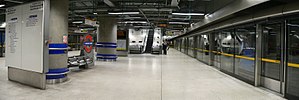
- JLE: Jubilee Line Extension
- The section of the Jubilee line between Green Park and Stratford, opened in 1999.
K
- KYT: Know Your Train
- KVB: Contrôle de Vitesse par Balises
- Translated to English as Speed control by beacons. A speed control system used on the French national rail network, Channel Tunnel and High Speed 1.
L
- LM: London Midland
- LNER: London North Eastern Railway
- LNR: London Northwestern Railway
- LO: London Overground
- LOM: Limit of Movement
- LOROL: London Overground Rail Operations Ltd.
- LOS: Limit of Shunt
- LPTB: London Passenger Transport Board
- LRT: London Regional Transport
- LRV: Light Rail Vehicle
- LSL: Locomotive Services Limited
- LT: London Transport
- LTE: London Transport Executive
- LTM: London Transport Museum
- LTP: Long Term Plan
- LUL: London Underground Ltd.
M
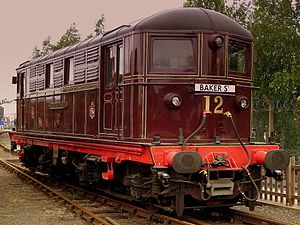
- MDR: Metropolitan District Railway
- MENTOR: Mobile Electric Network Testing Observation and Recording
- MML: Midland Main Line
- MOM: Mobile Operations Manager
- MR: Metropolitan Railway
- MTR: Mass Transit Railway (Hong Kong Subway)
N
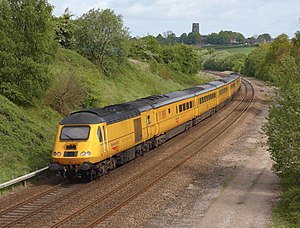
- NCT: Non-Communicating Train
- NIRM: Network Incident Response Manager
- NLC: National Location Codes
- NLE: Northern Line Extension
- NLL: North London Line
- NMT: New Measurement Train
- NR: Network Rail
- NR: Northern Rail
- NRM: National Railway Museum
- NRN: National Radio Network
- NSE: Network South East
- NTCO: Not To Call Order
O
- OA: Open Access
- OCS: Overhead Contact System
- OHLE: Overhead Line Equipment
- OLE: Overhead Line Equipment
- ONA: Operator Not Available
- OOL: On Our Lines (this project)
- OPO: One Person Operation
- The term used by London Underground to describe the running of trains where the only member of operation staff required is a T/Op. Analagous to DOO on National Rail
- OR: Operational Restriction
- A limitation placed on the CBTC system
- ORR: Office of Rail and Road
P
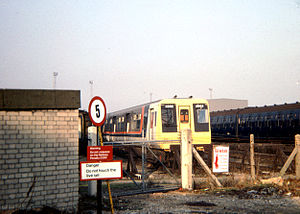
- PDL: Portsmouth Direct Line
- PEA: Passenger Emergency Alarm
- PED: Platform Edge Doors
- PEP: Prototype Electro Pneumatic Train
- PIS: Passenger Information System
- PLPR (1-4): Plain Line Pattern Recognition
- PM: Protected Manual
- PoSA: Proceed-on-Sight Authority
- PPE: Personal Protective Equipment
- PPI: Points Position Indicator
- PRI: Preliminary Route Indicator
- PRM: Persons with Reduced Mobility
- PSA: Passenger Service Agent
- PSB: Power Signal Box
- PSD: Platform Screen Doors
- PSR: Permanent Speed Restriction
- PTI: Platform Train Interface
- PTS: Personal Track Safety
- PU: Pick Up
Q
- Q Code train: A train that runs as required
R
- RA: Right Away (Indication)
- RAIB Rail Accident Investigation Branch
- RAT: Rail Adhesion Train
- A train which operates across London Underground lines in the autumn, spraying sandite onto rails to improve rail head conditions. See also RAT
- RCC: Rear Cab Clear (plunger)
- RDG: Rail Delivery Group
- REC: Railway Emergency Call
- RGI: Rail Gap Indicator
- RHTT: Rail Head Treatment Train
- A train which operates across Network Rail lines in the autumn, spraying water and sandite onto rails to remove crushed leaf debris, and to improve rail head conditions. See also RAT
- RM: Restricted Manual
- A mode of operation used in certain failure situations on London Underground ATO lines, where the Train Operator drives the train manually under authority from the signaller
- ROC (Network Rail): Rail Operating Centre
- ROC (SimSig:Sessions): Railway Operating Centre
- ROG: Rail Operations Group
- ROGS: The Railways and Other Guided Transport Systems (Safety) Regulations 2006 (as amended)
- RSF: Right Side Failure
- RSSB: Rail Safety and Standards Board
- RSI: Route Secure Indicator
- A form of route proving to permit movement during degraded modes of operation on London Underground
- RTT: Real Time Trains
- RTDI: Ready To Depart Indicator
- An ATO dispatch light located on the platforms of London Underground Jubilee and Northern lines.
- RVAR: Rail Vehicle Accessibility Regulations
S

- SATS: Staff Assisted Train Services
- SCAT: Speed Control After Tripping
- SCC: Service Control Centre
- SCD: Short Circuiting Device
- SCL1: Service Controller Level 1
- SCL2: Service Controller Level 2
- ScR: ScotRail
- SD: Set Down
- SDC: Service Delivery Centre
- SDO: Selective Door Opening
- SE: Southeastern
- SI: Section Isolator
- A break in the overhead wires, where two sections of wire are isolated from each other allowing current to either section to be isolated for maintenance. Also called a Section Insulator.
- SLL: South London Line
- SMA (0.5-14): Signal Migration Area
- SMD: Stratford Market Depot
- SMS: Safety Management System
- SN: Southern Rail
- SoT: Start of Traffic
- SotD: Signal of the Day
- SPAD: Signal Passed At Danger
- SPAR: Signal Passed At Red
- SPAS: Signal Passed At Stop
- SPT: Signal Post Telephone
- SR: ScotRail
- SRA: Strategic Rail Authority
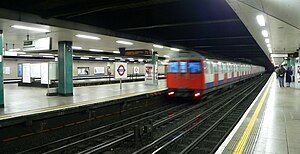
- SRAWS: Signal Repeating Automatic Warning System
- SSI: Solid State Interlocking
- SSO: Special Stop Order
- An order issued to on-train staff to stop at a station where the train is not otherwise booked to stop at. See also NTCO
- SSR: Sub-Surface Railway
- The Circle, District, Hammersmith & City and Metropolitan lines of London Underground
- STANME: Station Number Names
- STANOX: Station Numbers
- STI: Single track infringement
- STN: Special Train Notice
- Stock and Crew:
- A type of reform common on London Underground, where two drivers swap trains, taking the train number, destination and passengers with them. It is often used to ensure that trains requiring maintenance attention get back to the correct depots at the end of the day.
- STP: Short Term Plan
- SWML: South West Main Line
- SWR: South Western Railway
- SWT: South West Trains
T


- TAS: Traction Auxillary Set
- TAT: Traction Auxillary Trip
- TBC: Traction Brake Controller
- TBTC: Transmission Based Train Control
- Name given to the SelTrac installation used on London Underground’s Jubilee and Northern lines. See also CBTC and DTG-R
- TC: Track Circuit
- Part of the signalling system, where a simple electronic device is used to help detect the presence of a train. See also TCF and TSF.
- TCB: Track Circuit Block
- TCD: Traffic Controllers Diagrams
- TCF: Track Circuit Failure
- The failure of a track circuit used in signalling, giving the signaller an indication that a track circuit is occupied when there is no train present. See also TSF
- TCP: Trip Cock Protection
- TD (London Underground): Train Description
- TD (Network Rail): Train Describer
- TfGM: Transport for Greater Manchester
- TfL: Transport for London
- TfW: Transport for Wales
- TIPLOC: Timing Point Location
- TL: Thameslink
- TMS: Train Management System
- Onboard computer on trains which monitors the status of various systems and may manage the onboard information system.
- TMS: Tram Management System
- Onboard computer on trams which monitors the status of various systems and may manage the onboard information system.
- Signalling system used on the Manchester Metrolink.
- TMS: Tramway Museum Society
- TO: Technical Officer
- TOC: Train Operating Company
- TOD: Train Operators Display
- In cab display on 1995 & 1996 tube stock trains used to display train speed and signalling information to the Train Operator.
- T/Op: Train Operator
- TOPS: Total Operations Processing System
- TPE: TransPennine Express
- TPH: Trains Per Hour
- TPI: Trailing Points Indicator
- TPS: Train Planning System
- TPWS: Train Protection and Warning System
- Tracks down: Slang for Track Circuit Failure
- TRC: Track Recording Car
- TRT: Track Recording Train
- TRTS: Train Ready To Start
- TRU: Track Recording Unit
- TRV: Track Recording Vehicle
- TS: Tube Stock
- TSC: Transport Strategy Centre
- TSF: Track Section Failure
- The failure of a track circuit, or axle counter, used in signalling to give the signaller an indication of where a train is located. See also TCF
- TSI: Technical Specifications for Interoperability
- TSR: Temporary Speed Restriction
- TSW: Train Sim World
- TTN: Timetable Notice
- TYT: Track Your Train
U
- UDS: Unit Deselect
- UERL: Underground Electric Railway Company of London
- UTC: Urban Traffic Control
- A system that interfaces with tramway signalling to ensure balanced traffic flow and tram priority.
- UTO: Unattended Train Operation
- A form of train operation, where trains operate automatically without any members of staff onboard.
- UTU: Ultrasonic Test Unit
- UWC: User Worked Crossing
V
- VAR: Varied Timetable
- VCC: Vehicle Control Centre
- VIS: Vehicle Identification System
- Signalling system used on tramways, using loops resting on sleepers or underneath roads and receivers underneath trams to enable the signalling system to operate. Similar to VRS
- VOBC: Vehicle On Board Computer
- VRS: Vehicle Recognition System
- VSTP: Very Short Term Plan
- VT: Virgin Trains
- VTEC: Virgin Trains East Coast
W
- WAML: West Anglia Main Line
- WCML: West Coast Main Line
- WCRC: West Coast Railway Company
- WDM: Wrong Direction Move
- WLL: West London Line
- WMR: West Midlands Railway
- WMT: West Midland Trains
- WSF: Wrong Side Failure
- WSL: Wrong Signal Lowered
- WSLA: Wrong Signal Lowered and Accepted
- WTT: Working Timetable
X
- XC: Cross Country
- XR: Crossrail
Y
- Yellow Peril: Colloquial name for a London Underground staff circular briefing which details significant changes to signalling arrangements, such as the commissioning of a new signal cabin or modern automatic train control system
